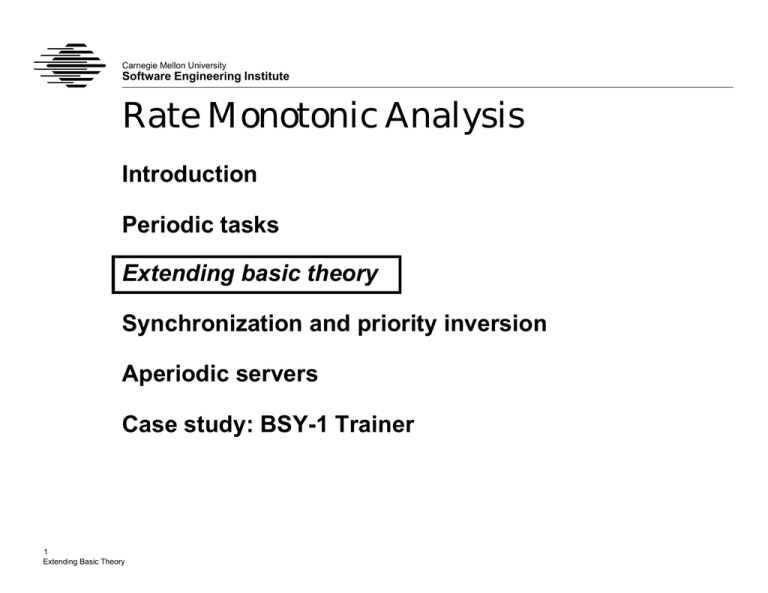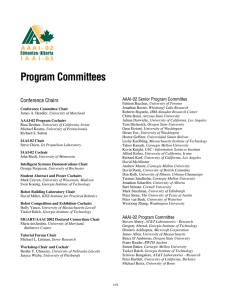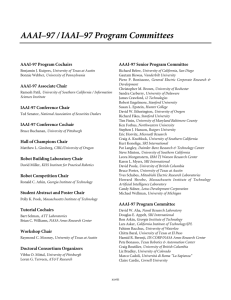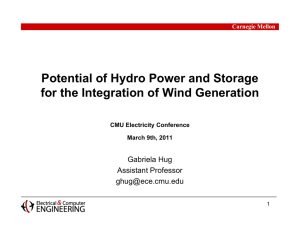Rate Monotonic Analysis
advertisement

Carnegie Mellon University
Software Engineering Institute
Rate Monotonic Analysis
Introduction
Periodic tasks
Extending basic theory
Synchronization and priority inversion
Aperiodic servers
Case study: BSY-1 Trainer
1
Extending Basic Theory
Carnegie Mellon University
Software Engineering Institute
Extensions to Basic Theory
This section extends the schedulability tests to address
• nonzero task switching times
• preperiod deadlines
• interrupts and non-rate-monotonic priorities
2
Extending Basic Theory
Carnegie Mellon University
Software Engineering Institute
Modeling Task Switching as
Execution Time
Ci + 2S
Ui =
100
0
τ1
Ti
C1
τ2
C1
C2
C1
200
C1
C2
C2
τ3
S
40
C1
time
40
T1
T2
2T1
Two scheduling actions per task
(start of period and end of period)
3
Extending Basic Theory
S
S
C2
S
S
Carnegie Mellon University
Software Engineering Institute
Modeling Preperiod Deadlines
Suppose task τ, with compute time C and period T, has
a preperiod deadline D (i.e. D < T ).
Compare total utilization to modified bound:
U total
Cn
C1
= ------ + ... + ------ ≤ U(n, ∆ i)
Tn
T1
where ∆i is the ratio of Di to Ti .
1 / n – 1) + 1 – ∆ ,
(
(
)
n
2∆
i
i
U(n, ∆ i) =
∆ , ∆ ≤ 1--i 2
i
4
Extending Basic Theory
1
--- < ∆ i ≤ 1.0
2
Carnegie Mellon University
Software Engineering Institute
Schedulability with Interrupts
Interrupt processing can be inconsistent with rate
monotonic priority assignment.
• interrupt handler executes with high priority
despite its period
• interrupt processing may delay execution of tasks
with shorter periods
Effects of interrupt processing must be taken into
account in schedulability model.
Question is: how to do that?
5
Extending Basic Theory
Carnegie Mellon University
Software Engineering Institute
Example: Determining Schedulability
with Interrupts
Task τ1:
Task τ2:
Task τ3:
Task τ4:
C
20
40
60
40
T
100
150
200
350
τ3 is an interrupt handler
6
Extending Basic Theory
U
0.200
0.267
0.300
0.115
Carnegie Mellon University
Software Engineering Institute
Example: Execution with Rate
Monotonic Priorities
0
τ1
τ2
τ3
τ4
7
Extending Basic Theory
100
200
300
400
Carnegie Mellon University
Software Engineering Institute
Example: Execution with an Interrupt
Priority
0
τ1
τ2
Interrupt
τ4
8
Extending Basic Theory
100
200
300
400
Carnegie Mellon University
Software Engineering Institute
Resulting Table for Example
9
Extending Basic Theory
Task
(i)
Period
(T)
Execution
Time
(C)
Priority
(P)
Deadline
(D)
τ3
τ1
τ2
τ4
200
100
150
350
60
20
40
40
HW
High
Medium
Low
200
100
150
350
Carnegie Mellon University
Software Engineering Institute
UB Test with Interrupt Priority
Test is applied to each task.
Determine effective utilization (fi) of each task i using
C j Ci 1
f i = ∑ ----- + ----- + ---- ∑ C k
T
T i T i k ∈ H1
j ∈ Hn j
Preemption
from tasks that can
hit more than once
(with period less than Di)
Preemption
from tasks that can
hit only once
(with period greater than Di)
Execution
of task under test
Compare effective utilization against bound, U(n).
• n = num(Hn) + 1
• num(Hn) = the number of tasks in the set Hn
10
Extending Basic Theory
Carnegie Mellon University
Software Engineering Institute
UB Test with Interrupt Priority: τ3
For τ3, no tasks have a higher priority: H = Hn = H1 = { }.
f3
C3
= 0 + ------ + 0 ≤ U ( 1 )
T3
Note that utilization bound is U(1): num(Hn) = 0.
Plugging in numbers:
C3
60
f 3 = ------ = --------- = 0.3 < 1.0
200
T3
11
Extending Basic Theory
Carnegie Mellon University
Software Engineering Institute
UB Test with Interrupt Priority: τ1
To τ1, τ3 has higher priority: H = {τ3}; Hn = { }; H1 = {τ3}.
C1 1
f 1 = 0 + ------ + ----- ∑ C k ≤ U ( 1 )
T1 T1k = 3
Note that utilization bound is U(1): num(Hn) = 0.
Plugging in the numbers:
C1 C3
20
60
f 1 = ------ + ------ = --------- + --------- = 0.800 < 1.0
100 100
T1 T1
12
Extending Basic Theory
Carnegie Mellon University
Software Engineering Institute
UB Test with Interrupt Priority: τ2
To τ2: H = {τ1,τ3}; Hn = {τ1}; H1 = {τ3}.
C j C2 1
f 2 = ∑ ----- + ------ + ----- ∑ C k
T
T2 T2k = 3
j=1 j
≤ U ( 2)
Note that utilization bound is U(2): num(Hn) = 1.
Plugging in the numbers:
C1 C2 C3
20
40
60
f 2 = ------ + ------ + ------ = --------- + --------- + --------- = 0.867
100 150 150
T1 T2 T2
13
Extending Basic Theory
> 0.828
Carnegie Mellon University
Software Engineering Institute
UB Test with Interrupt Priority: τ4
To τ2: H = {τ1,τ2,τ3}; Hn = {τ1,τ2,τ3}; H1 = { }.
C j C4
f 4 = ∑ ----- + ------ + 0
T
T4
j = 1, 2, 3 j
≤ U ( 4)
Note that utilization bound is U(4): num(Hn) = 3.
Plugging in the numbers:
C1 C2 C3 C4
f 4 = ------ + ------ + ------ + -----T1 T2 T3 T4
20
40
60
40
= --------- + --------- + --------- + --------- = 0.882
100 150 200 350
14
Extending Basic Theory
> 0.756
Carnegie Mellon University
Software Engineering Institute
Exercise: Schedulability with
Interrupts
Given the following tasks:
Task
(i)
Period
(T)
Execution
Time
(C)
Priority
(P)
Deadline
(D)
τint
τ1
τ2
6
4
10
2
1
1
HW
High
Low
6
3
10
Use the UB test to determine which tasks are
schedulable.
15
Extending Basic Theory
Carnegie Mellon University
Software Engineering Institute
Solution: Schedulability with
Interrupts
C int
--------- ≤ U ( 1 )
T int
0.334 < 1.0
{H1}
C 1 C int
------ + --------- ≤ U ( 1, .75 )
T1 T1
0.250 + 0.500 = 0.750 = U ( 1, .75 )
{Hn}
C int C 1 C 2
--------- + ------ + ------ ≤ U ( 3 )
T int T 1 T 2
0.334 + 0.250 + 0.100 = 0.684 < 0.779
16
Extending Basic Theory
Carnegie Mellon University
Software Engineering Institute
Basic Theory: Where Are We?
We have shown how to handle
• task context switching time: include 2S within C
• preperiod deadlines: change bound to U(n, ∆i)
• non-rate-montonic priority assignments
We still must address
• task interactions
• aperiodic tasks
We still assume
• single processor
• priority-based scheduling
• tasks do not suspend themselves
17
Extending Basic Theory
Carnegie Mellon University
Software Engineering Institute
Other Important Issues
Mode change
Multiprocessor systems
Priority granularity
Overload
Spare capacity assessment
Distributed systems
Post-period deadlines
18
Extending Basic Theory



